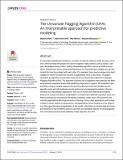| dc.contributor.author | Sheth, Mallory | |
| dc.contributor.author | Gerovitch, Albert S. | |
| dc.contributor.author | Welsch, Roy E. | |
| dc.date.accessioned | 2020-03-31T18:58:56Z | |
| dc.date.available | 2020-03-31T18:58:56Z | |
| dc.date.issued | 2019-10-11 | |
| dc.identifier.issn | 1932-6203 | |
| dc.identifier.uri | https://hdl.handle.net/1721.1/124462 | |
| dc.description.abstract | In many data classification problems, a number of methods will give similar accuracy. However, when working with people who are not experts in data science such as doctors, lawyers, and judges among others, finding interpretable algorithms can be a critical success factor. Practitioners have a deep understanding of the individual input variables but far less insight into how they interact with each other. For example, there may be ranges of an input variable for which the observed outcome is significantly more or less likely. This paper describes an algorithm for automatic detection of such thresholds, called the Univariate Flagging Algorithm (UFA). The algorithm searches for a separation that optimizes the difference between separated areas while obtaining a high level of support. We evaluate its performance using six sample datasets and demonstrate that thresholds identified by the algorithm align well with published results and known physiological boundaries. We also introduce two classification approaches that use UFA and show that the performance attained on unseen test data is comparable to or better than traditional classifiers when confidence intervals are considered. We identify conditions under which UFA performs well, including applications with large amounts of missing or noisy data, applications with a large number of inputs relative to observations, and applications where incidence of the target is low. We argue that ease of explanation of the results, robustness to missing data and noise, and detection of low incidence adverse outcomes are desirable features for clinical applications that can be achieved with relatively simple classifier, like UFA. | en_US |
| dc.language.iso | en | |
| dc.publisher | Public Library of Science (PLoS) | en_US |
| dc.relation.isversionof | 10.1371/journal.pone.0223161 | en_US |
| dc.rights | Creative Commons Attribution 4.0 International license | en_US |
| dc.rights.uri | https://creativecommons.org/licenses/by/4.0/ | en_US |
| dc.source | PLoS | en_US |
| dc.subject | General Biochemistry, Genetics and Molecular Biology | en_US |
| dc.subject | General Agricultural and Biological Sciences | en_US |
| dc.subject | General Medicine | en_US |
| dc.title | The Univariate Flagging Algorithm (UFA): An interpretable approach for predictive modeling | en_US |
| dc.type | Article | en_US |
| dc.identifier.citation | Sheth, Mallory et al. "The Univariate Flagging Algorithm (UFA): An interpretable approach for predictive modeling." PloS one 14 (2019) | en_US |
| dc.contributor.department | Sloan School of Management | en_US |
| dc.contributor.department | Massachusetts Institute of Technology. Department of Electrical Engineering and Computer Science | en_US |
| dc.relation.journal | PloS one | en_US |
| dc.eprint.version | Final published version | en_US |
| dc.type.uri | http://purl.org/eprint/type/JournalArticle | en_US |
| eprint.status | http://purl.org/eprint/status/PeerReviewed | en_US |
| dc.date.updated | 2020-02-11T13:06:01Z | |
| dspace.date.submission | 2020-02-11T13:06:03Z | |
| mit.journal.volume | 14 | en_US |
| mit.journal.issue | 10 | en_US |
| mit.license | PUBLISHER_CC | |
| mit.metadata.status | Complete | |
